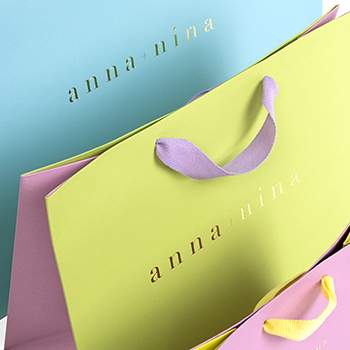Why do we give each other gifts and wrap them?
There’s nothing better than giving a gift to someone you love, apart from perhaps receiving a gift from that person.
There’s nothing better than giving a gift to someone you love, apart from perhaps receiving a gift from that person.
The world is full of countless gift-givers and receivers, delighting each other daily with presents. Gift-giving is especially widespread on special occasions and holidays, such as Christmas, birthdays, weddings, anniversaries, confirmations, Valentine’s Day and other important life events. But the best gift is often the “just because” gift, given without any particular reason, which only makes it all the more surprising.
But what is it that makes a gift unique? How do you heighten the recipient’s sense of expectation? Can you make gift-giving a holistic experience in itself, one that already begins before the package is opened? And: Why do we give gifts to each other in the first place? It’s precisely these questions we want to shed light on in this article. There is great brand value in making gift-giving into an experience, and perhaps this can inspire you in your choice of both packaging and packaging supplier.
Why do we give each other gifts?
Why do we give each other gifts?
Let’s start from the very beginning – and we mean way back in history, literally. In fact, according to Professor of Religious Studies at Aarhus University, Anders Klostergaard Petersen, we’re going all the way back 3.5 million years ago, when our ancestors first began exchanging gifts, e.g. in connection with atonement, acknowledgement of guilt, desire for forgiveness, or sacrifice.
In his view, the gift has always been a completely central part of human communities and has a clear function.
The gift is a fundamental phenomenon that can establish, maintain and preserve connections to – and between – people. In more recent times, gift giving has largely been interpreted as a kind gesture performed to please others. In other words, the good old relationship between a gift-giver who says “here you go”, and a gift-receiver who replies with a “thank you”. But behind the “here you go/thank you” relationship lie a number of possible motives that justify the act of gift-giving itself.
Let’s look at these a little more closely.

5 typical reasons why we give each other gifts
As a business owner, it makes sense to have a basic insight into why your customers choose to buy and give gifts. This knowledge can assist you in targeting your marketing – not least through your packaging and wrapping choices. Here are five examples of typical reasons for gift-giving.
There’s always a reason – according to tradition…
The first reason is quite simple: We give each other gifts because it’s an age-old tradition. Gift-giving is linked to major and significant events throughout our lives. As mentioned earlier, there are a multitude of occasions that call for gift-giving – from big anniversaries and milestones reached, to a stand-alone dinner party, where it’s seen as good form to bring a gift for the host/hostess.
Even if it’s a small box of chocolates or a bottle of wine, each individual gift helps to carry on the tradition from generation to generation; a fun tradition that typically spreads joy, creates a good atmosphere, and strengthens a sense of community.

To show love and to cultivate personal relationships
As Anders Klostergaard Petersen points out, for many, gift-giving is more than just the act itself.
Behind this gesture is an intention to establish, strengthen and maintain personal relationships.
The gift is a way to show and communicate our love, trust and connection to others.
And this relationship is confirmed by the gratitude and joy returned by the recipient. Whether the gift is taken directly from the recipient’s wish list or from the giver’s own imagination, it typically signifies something special for both gift-giver, recipient, and the personal relationship between the two.



It’s the thought that counts
Most people often associate gifts with physical items that can be wrapped and then unwrapped. But in fact, the value of gift-giving does not have to be materialistic.
A gift does not have to be a physical, material product to create the expected effect on the recipient. You can easily give a gift of an intangible nature, where it is the thoughts behind the gift that create the joy in the recipient.
A gift can be, for example, a gesture or an action. It can be writing a poem, a song or the like.
You can also arrange an experience that marks the festive occasion or your relationship with the recipient or donate to a charity, where it is the values and the message behind the gift that is essential.
In short: it is (often) more about the thought behind the gift that counts, rather than the product itself.

The “selfish” gift – with the expectation of something in return
If you ask Anders Klostergaard Petersen, there is no gift that is 100% selfless. In other words, we basically always give gifts bound to the expectation of receiving something in return – for example:
- Gratitude
- Joy
- Trust
- A suitable emotional response
- Recognition of personal skills
- A gift in return from the recipient
If you pursue this line of thinking, it’s just as much a question of “gift economy” as “gift exchange”. In other words – gift-giving that is also driven by the intention that this loving gesture will be reciprocated later on.



A souvenir that will last forever
The fifth and final reason concerns the giving of a gift that can act as an eternal reminder of the gift-giver or special experience between the gift-giver and the recipient.
A type of “souvenir” that holds meaning for these two parties, and which will always be a symbol of their relationship or experience.

Why do we wrap gifts?
Gift wrapping is a tradition that runs far back in history. But why do we, historically and culturally, wrap gifts?
Looking at history, gift giving in the old village communities was not just a generous gesture, it was also a way of marking social status between people. In short, giving a gift that could not be reciprocated showed superiority.
However, at the end of the 1800s, the finer members of the middle class began to wrap gifts. They did so in order to hide the price of the gift and take it out of the social power game so that it stood as a stand-alone tribute. Basically, one can say that gift wrapping was originally seen as a symbol of the degree of prosperity.
Typically, unwrapped gifts were associated with the lower classes of society, while the affluent wrapped their gifts. Gift wrapping spread to all parts of society throughout the 1900s. This is probably because gift wrapping made it easy to mask an otherwise inexpensive gift.



Use packaging as branding in your marketing
The outer part of the gift also has a lot of meaning, both for the giver, recipient, and for the shop where the gift was bought.
It’s about surprising and bringing joy to the recipient, and an aesthetically pleasing and unique package can help achieve this. What is important is to think about the packaging and gift wrapping, which:
Establishes a good first impression
Is eye-catching and stands out (aesthetic, look and feel, and elegant design details)
Reflects the quality of the gift
Attributes extra value with the gift (i.e., a focus on environmentally conscious packaging, packaging that can be reused, packaging that is part of the gift itself or something along those lines)
To make your packaging and gift wrapping unique and inviting, you can use many different visual and aesthetic elements.
For example, luxurious gift boxes, fine tissue paper or beautiful gift-wrapping paper of colours, prints, patterns, logos or similar decorative items.
You can also add a nice ribbon, an elegant bow or other eye-catching details that give the gift a nice look and finish. Also, use sustainable packaging; consumers are increasingly demanding environmentally friendly packaging, and this sends a clear signal that your company is taking responsibility for the environment.
In this way, you can make the gift a holistic experience, where the exterior is a small gift in itself. It helps bring the joy of anticipation and make the gift experience extraordinary even before it’s opened.
Such a wow factor increases the likelihood that your brand will be remembered.

Let the packaging communicate your message
It makes sense to think carefully about how your products look, both when being purchased and when given as gifts afterward. Here we return one last time to Anders Klostergaard Petersen, who emphasises that gift-giving in itself constitutes a means of communication, as the gift-giver typically wants to communicate something specific to a recipient.
In the same way, you can utilise your brand packaging and wrapping of the product to communicate specific messages and target your marketing. For example, you can design your packaging or wrapping to target gift-giving on specific holidays, special occasions, notable anniversaries or even specific customer bases – e.g. quality-conscious consumers looking for exclusive, high-end products.- Or environmentally conscious consumers that want sustainable alternatives in everyday life. And there’s good reason to consider packaging and wrapping as part of your marketing strategy, at least if the statistics in this area are to be believed.
The statistics speak for themselves A study by Shorr Packaging Corp, for example, shows that: 42% of customers notice if you do something extra with your wrapping. 51% of customers feel that the value of the product is higher if the wrapping has a special print or has been specially customised to the product. Following this, another study by Dotcom Distribution found: 40% of customers are more likely to repurchase from a company if the first product purchase is delivered in above-standard packaging. 43% of customers state that packaging is “very important” for the overall shopping experience when it comes to luxury items.
In other words, the packaging and wrapping of a gift is of great importance for the customer’s shopping experience, product perception, brand preferences and degree of customer loyalty.
And here we are talking both in relation to the person who buys your products as a gift, and the person who subsequently receives and unwraps the gift.
So, to summarise, it’s a good idea to:
- Gain a basic understanding of your customer’s seasonal gift needs and the reasons behind gift-giving.
- Consider how a moment of surprise can create more value
- Utilise this knowledge to design attractive and unique packaging and wrapping, which is in part targeted to these needs and reasons, and which in part can market your company’s brand effectively.

References:
Anders Klostergaard, Aarhus Universitetsforlag (2016): ”Gaven”.
Kristelig Dagblad (2016): Professor: Den uselviske gave findes ikke.
Shorr Packaging Corp: https://www.shorr.com/promos/2016-01/download-2016-e-commerce-packaging-survey-results
Dotcom Distribution: https://dotcomdist.com/thank-you-2016-packaging-study/
Let's talk
We would like to hear from you if you have any question or need a quote. Fill out this form and one of us will get it touch with your shortly.
Other stories
ARTICLE
Get your packaging strategy in 3 steps
Have you thought about your company’s packaging strategy? We find that many stores and webshops plan their packaging on a case-by-case basis. Is this your strategy too?
ARTICLE
Save time by using gift bags
Although it is primarily the gift itself that counts, the packaging also matters a lot. A beautiful and aesthetically wrapped gift is an expression of the thought and effort that the gift-giver put into the gift as a whole. However, wrapping a gift and tying the perfect bow isn’t easy for everyone.
ARTICLE
Surprise your customers with these 5 different packaging designs
With a branded packaging design with well thought-out details, you can complete the customer experience. There is plenty of opportunity to have packaging designed to reflect your brand and make it stand out from the competition.






